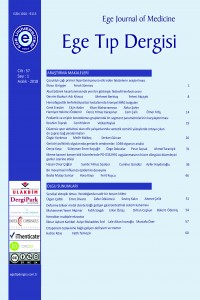Abstract
Herediter multiple ekzostoz, çoğunlukla uzun kemiklerin juksta-epifizer bölgesinden köken alan ekzositozlarla karakterize otozomal dominant bir hastalıktır. Hastalar en sık eklem yakınında tek veya çok sayıda sert, ağrısız kitlelerle prezente olur. En yaygın komplikasyonları ağrı, eklem hareket kısıtlılığı, ekstremite eşitsizlikleri, büyüme geriliği, damar-sinir basısı ve malign dejenerasyondur. Bu yazıda, herediter multiple ekzostoz tanılı bir olguyu sunmayı ve ilgili literatür eşliğinde klinik özelliklerini ve tedavide rehabilitasyonun etkinliğini tartışmayı amaçladık.
References
- Ryckx A, Somers Jan FA, Allaert A. Hereditary Multiple Exostosis. Acta Orthop Belg 2013;79(6):597-607.
- Stieber JR, Dormans JP. Manifestations of Hereditary Multiple Exostoses. J Am Acad Orthop Surg 2005;13(2):110-20. 3. Bovée JV. Multipl osteochondromas. Orphanet J Rare Dis 2008;13(3)3.
- Jamsheer A, Socha M, Sowińska-Seidler A, Telega K, Trzeciak T, Latos-Bieleńska A. Mutational screening of EXT1 and EXT2 genes in Polish patients with hereditary multiple exostoses. J Appl Genetics 2014;55(2):183-8.
- Wuyts W, Van Hul W, De Boulle K, et al. Mutations in the EXT1 and EXT2 genes in hereditary multiple exostoses. Am J Hum Genet 1998;62(2):346-54.
- Legeai-Mallet L, Margaritte-Jeannin P, Lemdani M, Le Merrer M, Munnich A. An extension of the admixture test for the study of genetic heterogeneity in hereditary multiple exostoses. Hum Genet 1997;99(3):298-302.
- Temizöz O, Bayram İ, Akpınar F, Etlik Ö, Güler M, Sakarya ME. Malign transformasyon gösteren osteokondromatozis olgusunda radyolojik bulgular. Tıp Araştırmaları Dergisi 2003:1(3):31-4.
- Darilek S, Wicklund C, Novy D, et al. Hereditary multiple exostosis and pain. J Pediatr Orthop 2005;25(3):369-76.
- Goud AL, de Lange J, Scholtes VA, Bulstra SK, Ham SJ. Pain, physical and social functioning, and quality of life in individuals with multiple hereditary exostoses in The Netherlands: A national cohort study. J Bone Joint Surg Am 2012;94(11):1013-20.
Abstract
Hereditary multiple exostoses is an autosomal dominant disease which is characterized by exostoses that originate
most commonly from the juxta-epiphysial region of the long bones. Patients usually present with single or multiple,
firm, painless masses near the joints. The most common complications are pain, restricted joint motion, extremity
asymmetry, growth retardation, neurovascular compression and malignant degeneration. In this paper, we aimed to
present a case with diagnosis of hereditary multiple exostoses and discuss the clinical features and efficacy of
rehabilitation with relevant literature
References
- Ryckx A, Somers Jan FA, Allaert A. Hereditary Multiple Exostosis. Acta Orthop Belg 2013;79(6):597-607.
- Stieber JR, Dormans JP. Manifestations of Hereditary Multiple Exostoses. J Am Acad Orthop Surg 2005;13(2):110-20. 3. Bovée JV. Multipl osteochondromas. Orphanet J Rare Dis 2008;13(3)3.
- Jamsheer A, Socha M, Sowińska-Seidler A, Telega K, Trzeciak T, Latos-Bieleńska A. Mutational screening of EXT1 and EXT2 genes in Polish patients with hereditary multiple exostoses. J Appl Genetics 2014;55(2):183-8.
- Wuyts W, Van Hul W, De Boulle K, et al. Mutations in the EXT1 and EXT2 genes in hereditary multiple exostoses. Am J Hum Genet 1998;62(2):346-54.
- Legeai-Mallet L, Margaritte-Jeannin P, Lemdani M, Le Merrer M, Munnich A. An extension of the admixture test for the study of genetic heterogeneity in hereditary multiple exostoses. Hum Genet 1997;99(3):298-302.
- Temizöz O, Bayram İ, Akpınar F, Etlik Ö, Güler M, Sakarya ME. Malign transformasyon gösteren osteokondromatozis olgusunda radyolojik bulgular. Tıp Araştırmaları Dergisi 2003:1(3):31-4.
- Darilek S, Wicklund C, Novy D, et al. Hereditary multiple exostosis and pain. J Pediatr Orthop 2005;25(3):369-76.
- Goud AL, de Lange J, Scholtes VA, Bulstra SK, Ham SJ. Pain, physical and social functioning, and quality of life in individuals with multiple hereditary exostoses in The Netherlands: A national cohort study. J Bone Joint Surg Am 2012;94(11):1013-20.
Details
| Primary Language | Turkish |
|---|---|
| Journal Section | Case Report |
| Authors | |
| Publication Date | March 1, 2018 |
| Submission Date | November 1, 2016 |
| Published in Issue | Year 2018 Volume: 57 Issue: 1 |
Ege Journal of Medicine enables the sharing of articles according to the Attribution-Non-Commercial-Share Alike 4.0 International (CC BY-NC-SA 4.0) license.

